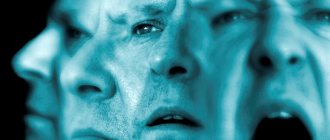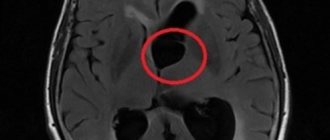Senestopathies (Greek koinos - general, aisthesis - feeling, sensation, pathios - suffering, disease) are pathological sensations, the development of which is not associated with somatic disorders and external influences on sensory organs. The following terms are also used: co-anesthesia, sensations, psychosomatic sensations, somatic hallucinations, somatoform disorder, bodily illusions, dissomesthesia. Described by E. Dupre and P. Camus in 1907. The diagnostic criteria for senestopathy are as follows:
Polymorphism is an extreme variety in which almost all modalities of sensations are represented, as well as numerous submodal sensations. Patients themselves prefer to call them “pains”, although, strictly speaking, senestopathies themselves are very often not pain, this is easily clarified during targeted questioning. Quite often, patients continually change the description of senesthopathy, as if they could not find their exact verbal formula. Often the same patient presents with different senestopathies;
| | Our psychiatric clinic will help you cope with sensoropathy |
Unusual, sometimes very strange, pretentious nature of sensations , which sharply distinguishes them from natural painful sensations caused by somatic pathology. The impression of unusualness is largely due to the fact that the location, projection, configuration and interpretation of senestopathic sensations are very different from what is usually reported by somatic patients. Along with senestopathies, patients may present quite typical complaints of a somatic nature; this circumstance indicates the preservation of the normal process of sensation formation. At the same time, many patients describe ordinary somatic complaints in a rather strange way. The latter circumstance requires caution in assessing the somatic complaints of patients;
The painful affective tone of senestopathic sensations . This is manifested, firstly, by the fact that senestopathies are often a source of extreme suffering for patients, sometimes leading to suicidal thoughts. There are cases when, according to patients, they have never experienced anything more painful in their entire lives. Secondly, various fears are often associated with senestopathies, for example, fear of serious illness, madness, or death. This long-known fact was called “fear in the head” by German authors;
The persistent, seemingly persistent, persistent or even haunting nature of senestopathic sensations . It seems to patients that senestopathies have the ability to forcefully attract their attention. In other words, patients are thereby describing the symptom of painful reflection;
Depressed mood , usually accompanying senestopathies. Depression predominates, combined with anxiety and fears. Depressed mood, meanwhile, is not always recognized by patients. Typical of most of them is a tendency to psychologize their condition. In the minds of such patients, the cause of depressed mood is exclusively senestopathies:
“What kind of mood can you be in when it hurts?” It is often possible to observe that the dynamics of senestopathies are parallel to mood swings. In particular, senestopathies can occur in attacks, accompanied by panic. Such senestopathic attacks are more often regarded as a manifestation of affective pathology, i.e., panic attacks. Cases of mania with senestopathies are very rare;
The uncritical nature of patients , who usually believe that senestopathies, even the most unusual ones, are a sign not of a mental illness, but of some kind of somatic, sometimes serious, disease. Sometimes there are patients with senestopathies and thematically associated delusions of somatic disease;
The area of sensitivity in which senestopathies develop is somesthesia. Painful phenomena in exteroceptive modalities of sensation similar to senestopathies are unknown. In other words, such cross-modal relationships in which the painful qualities of interoreception would be reflected in disturbances of exteroreception apparently do not exist.
There are different approaches to systematizing senestopathies. One of them is anatomical. Thus, A.K. Anufriev (1979) distinguishes the following five types of senestopathies: cardiovascular, central neurological, abdominal, musculoskeletal, and skin-subcutaneous. The author notes that senestopathies localized in the head and heart are especially common.
This approach, and this is where its undoubted advantages lie, is most acceptable in cases of senestopathies with persistent and specific localization. Perhaps it also reflects the point of view according to which senestopathies are somehow related to current or previously occurring somatic pathology. In addition, we cannot exclude the possibility that the localization of senestopathies to a certain extent reflects the patients’ opinion about the significance of the functions of certain organs for him, i.e., it emphasizes the role of psychological factors in the genesis of senestopathies. Some observations have shown, for example, that the localization of senestopathies in the genitals is prognostically unfavorable.
Another approach to systematizing senestopathies is associated with a clinical-psychopathological assessment of the latter. The central idea of this approach is that the severity of the lesion in senestopathies can be established by signs indicating their place in the well-known scale of productive mental disorders, which was presented by A.V. Snezhnevsky in 1983. According to this scale, the severity of a particular symptom is determined by the structure of which syndrome this symptom is included in (it is included and thereby modified in one way or another, and does not simply accompany the main psychopathological syndrome).
Meanwhile, a number of researchers have established that in senestopathies signs of depersonalization, delusions, hallucinations, phenomena of mental automatism and even paraphrenia can be identified (Ushakov, 1973; Ostroglazov, 1975; Eglitis, 1977; Anufriev, 1978; Guteneva, 1979, 1980; Basov, 1980, etc.). Thus, it becomes possible to systematize senestopathies depending on how deep the brain damage that gave rise to them is. This approach forms the basis of this description of senestopathies. The following types of senestopathies will be mentioned: simple, psychosensory, interpretive, hallucinatory and paraphrenic.
Treatment of senestopathy
Diagnostic measures involve collecting a complete and high-quality medical history, as well as complaints and additional studies. It is important to distinguish between senesthopathy and other somatic diseases. If a disease of the internal organs develops, then the distinctive feature will be a feeling of a certain localization and relationship with the position of the organ. Typically, the following types of examinations are carried out:
- MRI
- Ultrasound
- CT.
Symptomatic treatment for senestopathy does not bring the desired results. To stop the disease, analgesics and physiotherapeutic measures are used. Psychologists may be assigned to work to alleviate mental disorders. If the patient suffers from depression or neurosis, antidepressants, antipsychotics and tranquilizers may be prescribed. Psychotherapeutic measures also help reduce the manifestations of the disease.
Description of senestopathies
Senestopathies are unpleasant, painful, sometimes painful sensations in different parts of the body. They can be localized both externally and in internal organs and reach such a degree of severity that they become unbearable. Many patients describe the physical suffering caused by senesthopathy as more severe than physical pain.
In fact, these are only the patient’s own experiences; in reality, no pathologies are found at the site of the sensation. Senestopathies are a consequence of disorders in the functioning of the brain and psyche. These conditions are caused by changes in the functioning of the central nervous system, brain, and mental disorders. Senestopathies can also occur with various neuroses, manic-depressive psychosis, oneiric syndrome, paranoia, hypochondria and some other mental disorders.
Symptoms of senestopathy
The symptoms of Senesthopathy are characterized by a large number of different painful sensations that are not localized. When trying to describe feelings, he cannot clearly define where it hurts and in what intensity. Often, experts observe a strong emotional coloring: painful and painful sensations. It is important to note that some patients report emotional distress rather than physical distress. They constantly concentrate on possible painful sensations, unable to be distracted by another subject.
Another difference is the unusual projection. The patient often indicates pain in a place where, according to medical indicators, there should not be pain. Most often, unpleasant sensations manifest themselves in the form of headaches, less often in the chest, heart and limbs. Senesthopathy can occur periodically or on an ongoing basis, sometimes manifesting as attacks.
Psychogenic nature of burning and itching
The term “psychosomatics” is quite common these days. It is defined as the occurrence of bodily manifestations based on psychological factors.
If during the examination of the patient it is not possible to find objective reasons causing such impressions, the matter is most likely in the mental sphere of the person. Or rather, in its negative manifestations.
For example, itching and burning sensations in the body develop against the background of a stressful situation . If it was a one-time problem, then after it is eliminated, the unpleasant manifestations also disappear.
As for chronic stress , these symptoms may persist or even intensify. This, in turn, increases nervous tension and aggravates the situation. It turns out to be a vicious circle.
There is an understandable explanation for the appearance of skin paresthesias in psychological disorders. With negative emotions, the body increases the production of serotonin and dopamine. It is these neurotransmitters that provoke the occurrence of itching and burning, usually without visible skin elements. But sometimes a rash, dryness and peeling may appear.
Types of senestopathy
It is customary to distinguish several types of senestopathy, which are most often diagnosed in patients.
Senesthopathy syndrome
A painful sensation that can spread to different parts of the body. It can take different forms:
- pressing
- Burning
- Pulling
- Rolling
- contracting
- Boring
- Tearing.
They differ from ordinary pain sensations because they do not have a clear localization. It is important to note that the disease has no clear age boundaries and develops regardless of gender.
Senesthopathy with neurosis
With neurosis, pain occurs quite rarely. Some of the most common symptoms include the following:
- Apparent lesion of a certain area, which is accompanied by cold or burning sensation
- A feeling as if the affected area begins to spin, becomes mobile and has no clear boundaries
- When painful sensations appear, burning and burning pain often appears
- Spread of tense feeling or hardening of certain areas in the body.
As for the descriptions and complaints of patients, they are of an abstract nature, since the person himself is not able to understand what exactly hurts him.
Hallucinations with senestopathy
When senesthopathy and hallucinations occur, the patient cannot understand what is real and what are fictitious events. Among the somatic pathologies identified:
- Lack of differentiation at the sensory level
- Novelty is subjective
- High degree of sensory saturation
- Spatial description of the disease. Characteristics such as unusual, flamboyant, strange, or incongruous often appear in the history.
Accompanied by a change in emotional state, as well as the inability to differentiate this syndrome.
Hypochondriacal senestopathy
This is a whole complex of symptoms, as a result of which the patient develops a belief in something that is not actually happening. A distinctive feature is excessive control of one’s own health, even at a time when it is not necessary.
The development of hypochondriacal senestopathy is evidenced by the following aspects:
- The appearance of heaviness in the abdominal area
- Often loss of appetite and disturbed sleep
- A person constantly strives to discover some non-existent disease in himself.
- The emergence of a feeling of depression.
As diagnostic measures, anamnesis and the patient’s story about his condition are primarily used.
Forecast
Is there a danger to life with senestopathies? This question can be answered in the negative. In this condition, there is no threat to life or physical damage to the body. These conditions are dangerous only in that a person experiencing constant pain or some unpleasant sensations gradually becomes more irritable. Aggression begins to increase and his behavior changes frequently.
The progression of aggressive behavior in a sick person, especially over a long, debilitating course or with ineffective help, can provoke harm to both oneself and others. Life-threatening behavior is possible, and therefore, in these rare cases, emergency psychiatric care and possibly hospitalization with 24-hour close supervision may be required.
Diseases that provoke the occurrence of senestopathy
Below is a list of the most common diseases in which the symptom of senestopathy may appear.
- Organic lesions of the nervous system of any origin (vascular, atrophic, traumatic, toxic, infectious).
- Consequences of poisoning (including the consequences of alcoholism, drug addiction and substance abuse).
- Schizophrenia and so-called disorders schizophrenia spectrum.
- Affective disorders (bipolar affective disorder, depression, manic states).
- Neurotic disorders.
Depending on the content of the patient’s complaints, various types of disease are distinguished.
Treatment of senestopathy (psychiatry)
First of all, a specialist must differentiate the patient’s condition and exclude possible physiological diseases of the internal organs. In addition to physical examination, psychotherapists and psychologists work with the patient to make a diagnosis.
If the disease is accompanied by psychosis, then antipsychotics can be used in treatment. With the development of neurosis - antidepressants and tranquilizers.
When senestopathy becomes chronic, this means that qualitative changes have occurred in the brain, which may be irreversible. If such a pathology occurs, then psychotropic drugs will no longer be able to cope with the disease. As an additional therapy, many specialists use hypnosis to find out the causes of the syndrome and reduce the manifestation of side symptoms.
The treatment plan is created exclusively on an individual basis after all examinations have been completed. Therefore, there is no clear picture of treatment in general terms and specialists primarily rely on the collected anamnesis.
Help from a psychotherapist
For mild deviations and in the initial stages, psychological methods of influence can be used to treat senestopathies. They are especially effective only after some relief of symptoms with drug therapy. For neuroses and unusual sensations, sessions with a psychotherapist are included in the mandatory program of comprehensive treatment. Most often, a specialist chooses the following methods:
- hypnosis;
- body-oriented psychotherapy;
- reconstructing positive thoughts;
- suggestion;
- learning ways to relax and switch attention.
Introduction to trance for senestopathy is rarely used, only if other methods are ineffective. Psychocorrection of a problem at the subconscious level using hypnosis is considered by experts as an aggressive influence. A gentle and effective method is body-oriented psychotherapy. The doctor helps the patient mentally move all organs and parts of the body to a zone of maximum comfort and well-being. This allows you to remove internal clamps and eliminate discomfort.
Positive thinking begins with a person’s concentration on the painful area, when he concentrates as much as possible and, with the help of aromatherapy or pleasant music, frees himself from his problem. In highly suggestible patients with mental disorders, it helps to gradually convince them that their fears are pointless and that there is no danger of developing a serious illness. This treatment of anxiety, neurosis, hypochondria and unusual sensations is considered the most effective.
An integrated approach and successful treatment of mental disorders at Dr. Isaev’s clinic allows you to get a positive result in the shortest possible time. After therapy, many patients return to their families, to their place of work and can live a full life, no different from others. The most important thing is to seek help as quickly as possible.
What can itching and feeling of heat in the body lead to?
These symptoms are so uncomfortable that it is simply impossible to ignore them. All attention is concentrated on them, which is why a person becomes inattentive, absent-minded, disruptions appear in his professional activities, and his performance decreases.
Irritability and tension reach a peak state. Depression and nervous breakdowns are possible. Such overexertion leads to mental imbalance. The patient's sleep is disturbed and insomnia develops. As a result, during the day he feels exhausted and sleep-deprived.
Severe itching in the intimate area sometimes leads sufferers to the point that they use various objects that injure the mucous membrane and skin in this area.
Scratches on the skin and mucous membranes can become infected, inflamed and suppurate, spreading the process to larger areas.











